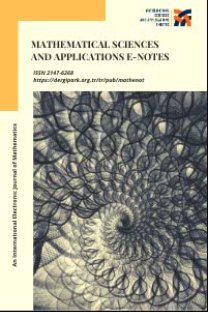Some Applications of the (p, q)-Lucas Polynomials to the bi-univalent Function Class Σ
___
[1] Altınkaya, ¸S., Yalçın, S.: Faber polynomial coefficient bounds for a subclass of bi-univalent functions. C.R. Acad. Sci. Paris, Ser. I 353 (12), 1075-1080 (2015).[2] Altınkaya, ¸S., Yalçın, S.: Fekete-Szegö inequalities for certain classes of bi-univalent functions. Internat. Scholar. Res. Notices 2014, 1-6 (2014). Article ID 327962.
[3] Brannan, D. A., Taha, T. S.: On some classes of bi-univalent functions. Stud. Univ. Babe¸s-Bolyai Math. 31, 70-77 (1986).
[4] Duren, P. L.: Univalent Functions. Grundlehren der Mathematischen Wissenschaften, Bd. 259, Springer-Verlag, Berlin, Heidelberg, New York and Tokyo, (1983).
[5] Fekete, M., Szegö, G.: Eine Bemerkung Über Ungerade Schlichte Funktionen. J. London Math. Soc. [s1-8(2)], 85-89 (1933).
[6] Lewin, M.: On a coefficient problem for bi-univalent functions. Proc. Amer. Math. Soc. 18, 63-68 (1967).
[7] Lee, G. Y., A¸scı, M.: Some properties of the (p, q)-Fibonacci and (p, q)-Lucas polynomials. J. Appl. Math. 2012, 1-18 (2012). Article ID 264842.
[8] London, R. R., Thomas, D. K.: The derivative of Bazilevic˘ functions. Proc. Amer. Math. Soc. 104, 235-238 (1988).
[9] Lupas, A.: A guide of Fibonacci and Lucas polynomials. Octagon Mathematics Magazine 7, 2-12 (1999).
[10] MacGregor, T. H.: Functions whose derivative has a positive real part. Trans. Amer. Math. Soc. 104, 532-537 (1962).
[11] Netanyahu, E.: The minimal distance of the image boundary from the origin and the second coefficient of a univalent function in |z| < 1. Arch. Ration. Mech. Anal. 32, 100-112 (1969)..
[12] Özkoç, A., Porsuk, A.: A note for the (p, q)-Fibonacci and Lucas quaternion polynomials. Konuralp J. Math. 5 (2), 36-46 (2017).
[13] Filipponi, P., Horadam, A. F.: Derivative sequences of Fibonacci and Lucas polynomials. In: Applications of Fibonacci Numbers, Springer, Dordrecht, (1991).
[14] Srivastava, H. M., Murugusundaramoorthy, G., Magesh, N.: Certain subclasses of bi-univalent functions associated with the Hohlov operator. Appl. Math. Lett. 1, 67-73 (2013).
[15] Singh, R.: On Bazilevic˘ functions. Proc. Amer. Math. Soc. 38, 261-271 (1973).
[16] Srivastava, H. M., Mishra, A., Gochhayat, P.: Certain subclasses of analytic and bi-univalent functions. Appl. Math. Lett. 23, 1188-1192 (2010).
[17] Srivastava, H. M., Mishra, A. K., Das, M. K.: The Fekete-Szegö problem for a subclass of close-to-convex functions. Complex Variables Theory Appl. 44 (2), 145-163 (2001).
[18] Vellucci, P., Bersani, A.M.: The class of Lucas-Lehmer polynomials. Rendiconti di Matematica 37 (1-2), 43-62 (2016).
[19] Wang, T., Zhang, W.: Some identities involving Fibonacci, Lucas polynomials and their applications. Bull. Math. Soc. Sci. Math. Roum. 55 (1), 95-103 (2012).
[20] Zaprawa, Z.: On Fekete-Szegö problem for classes of bi-univalent functions. Bull. Belg. Math. Soc. Simon Stevin 21, 169–178 (2014).
- ISSN: 2147-6268
- Yayın Aralığı: 4
- Başlangıç: 2013
- Yayıncı: -
Arzu CİHAN, Ayşe ZEYNEP AZAK, MEHMET ALİ GÜNGÖR
On M-injective and M-projective Modules
Oğuzhan DEMİREL, Leyla ASLAN, Damla TOPAL
Certain Semisymmetry Curvature Conditions on Paracontact Metric (k, µ)-Manifolds
A New Paranormed Series Space and Matrix Transformations
Ramkrishna M. DHAIGUDE, Christophe CHESNEAU, Yogesh J. BAGUL
